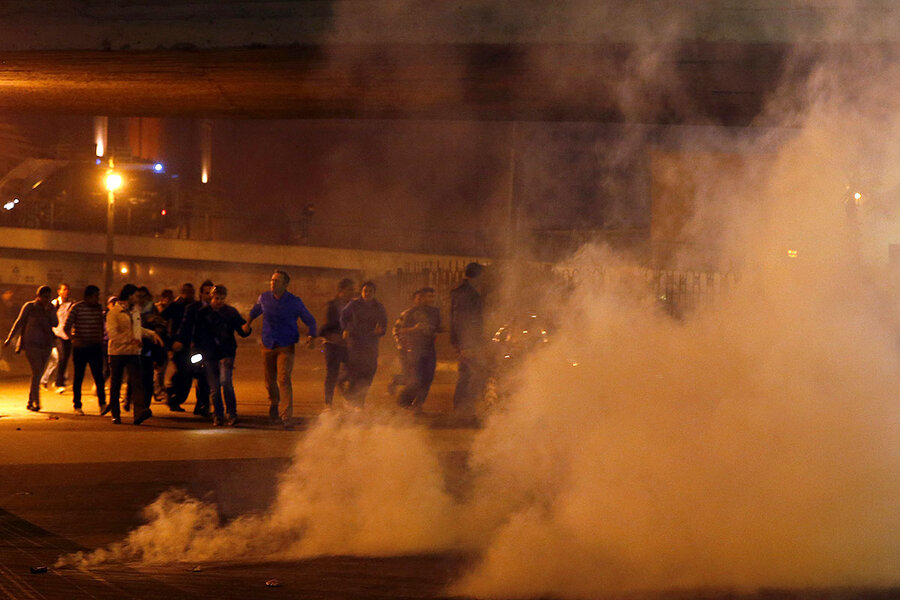Horrified by strife in my America, finding hope in my Mideast
Loading...
| Amman, Jordan
I still feel every second. Visored, armor-clad police form a wall, riot shields up, clubs in hand, their faces barely visible. The faint bitter-sour smell of tear gas hangs in the air.
My calves twitch, ready to move in either direction, not knowing where the battle lines lie, how close is too close. The police move a few steps forward; the crowd rushes back a few strides, before boldly inching back to hold its ground.
Chants for social justice fill the air, but in the back of all our minds are questions: Who will stand down, who will flinch, who will cross the line, who will get hit? Who will not return home tonight?
Why We Wrote This
For the Monitor’s Chicago-born Arab world correspondent, the view homeward of roiling strife and demands for justice has been both disorienting and familiar. His experience has taught him to hope.
Suddenly tear gas is fired. The police rush in through the smoke from every direction. Chants turn to screams. It is now a scramble to get out in one piece. Journalists hold up press cards – yell “media!” – but the clubs rain down.
This isn’t Minneapolis, Atlanta, or Detroit. This is Cairo, this is Amman. Nearly a decade ago and for a different cause, millions of young people protested for justice and freedoms across the Arab world, going up against a militarized police force with lives at stake.
I covered dozens of such protests in cities and villages across the region. Some were peaceful, some turned violent, but all featured the same potent mix of hope, anger, and uncertainty about how it would all end.
Now I see these images replay in my hometown of Chicago: clashes in the Loop, State Street scuffles, pandemonium on the North Side. Armored vehicles like those used to clear out Cairo’s Tahrir Square rolling down Michigan Avenue and the Eisenhower.
It is as if my life’s memories have been jumbled and reassembled, replacing the backdrops of the Mideast capitals I lived in with the streets where I am from. Like a puzzle gone wrong.
During the 2011 Arab Spring, the American government was a voice of restraint, championing the right to peaceful protest for justice and democracy. Warnings from the U.S. president himself against the use of force against protesters stopped many Arab leaders from escalating violence further and transforming their cities into “battle spaces.”
There was a cause and effect to our work as journalists; the abuses by police forces that we documented led to condemnations from Western governments, rattling Arab regimes that rely on Western aid.
Sure, I took my lumps: a club to the back of the neck, a rock to the head, an errant machete grazing my leg. I still bear a mark on my shoulder from when an entire barbecue grill was thrown at me. But we could count on America’s voice to pull us back from the brink.
But what happens when that voice – the United States government’s – is either silent or, instead, fanning the flames?
What happens when America’s democratic norms shatter, divisions deepen, and age-old racial inequalities and racist impulses intensify? What happens when the chaos comes home?
Separated by thousands of miles of ocean, COVID-19 restrictions, and shuttered airports, I cannot be with my hometown community. I cannot support my grieving and enraged homeland the way I have done in foreign lands. All I can do is witness.
If I am stuck reliving times of turmoil, perhaps my solace is that I have also lived the aftermath. And it’s not all bad. In fact, there is good to be found.
Years before “silence is compliance” became a protest chant, the U.S. government fell silent on injustices in this part of the world.
As America diplomatically retreated from the Mideast, Arab strongmen gained the upper hand. Militarized police became even more militarized; protests were crushed with deadly force; leaders passed anti-terror laws marking anyone who dares to speak out or criticize their government a “terrorist.”
But something else happened, too. People banded together.
As authoritarians tightened their grip, polarization subsided; rifts among Islamists, secular citizens, and regional tribes healed. I watched people of different faiths and political stripes rally around one another for civil liberties, jobs, and a better future for their children.
Neighbors and strangers relied on each other because no government or political movement was coming to save them.
Activism lived on in acts of kindness. Less than a decade after the Arab Spring, a new generation infused with the culture of protests and speaking truth to power has come of age, rising up in Sudan, in Iraq, in Algeria, in Lebanon.
While paranoid strongmen build up arsenals of tanks and guns, an entire generation of young Arabs has been armed with the knowledge: True power is people power.
I hold these lessons close now: Divisions can’t destroy decency, good neighbors don’t stay divided, kindness cannot be killed. Even in darkness, communities find one another. And progress can be derailed, but not erased – no matter who or what stands in the way.






